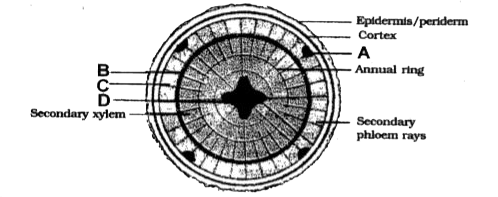Discuss the various stages of secondary growth in a typical dicot root.
Text Solution
The secondary growth in dicot roots occur due to the activity of vascular cambium. During secondary growth following events occur.

(i)Formation of vascular cylinder The cells of conjunctive tissue lying just below the phloem and in between the xylem become meristematic. It forms vascular cambium. At the same time cells of pericyle lying outer to protoxylem become meristematic and form a strip of cambium. Thus a continuous band of wavy vascular cambium is formed.
(ii) Formation of secondary xylem and secondary phloem The vascular cambium cells divide periclincal and form the cells on both sides. The cells formed on the inner side are developed into secondary xylem while outward cells are developed into secondary phloem. In the beginning more and more secondary xylem is formed. As a result of it wavy band of vascular cambium is converted into circular ring. The ray initial of vascular cambium gives rise to vascular rays. They help in the radial conduction.
(iii) Secondary ground tissue The cork cambium is formed from the pericycle. Thus cork cambium in root is secondary in origin. The cells of cork cambium divide tangentially and form secondary cortex toward inner side while cork toward outside.
|
Similar Questions
Knowledge Check
Given diagram is old typical dicot root.
 AA- Primary phloem, B - Vascular cambium, C-Secondary phloem, D - Primary xylemBA-Secondary phloem, B - Vascular cambium, C - Primary phloem, D - Primary xylemCA- Primary phloem, B - Primary xylem, C-Secondary phloem, D - Vascular cambiumDA-Secondary phloem, B - Primary xylem, C- Primary phloem, D - Vascular cambium
AA- Primary phloem, B - Vascular cambium, C-Secondary phloem, D - Primary xylemBA-Secondary phloem, B - Vascular cambium, C - Primary phloem, D - Primary xylemCA- Primary phloem, B - Primary xylem, C-Secondary phloem, D - Vascular cambiumDA-Secondary phloem, B - Primary xylem, C- Primary phloem, D - Vascular cambium
secondary growth in dicot roots
View Solutionstele in angiosperms, secondary growth in dicot root
View Solutionsecondary Growth in dicot stems
View SolutionAnomalous secondary growth found in dicot root of
View SolutionDescribe the process of secondary growth in a dicot stem
View SolutionLenticels ||Secondary Growth in dicot root
View SolutionAfter two years of secondary growth the cortex in a dicot root
View Solution
